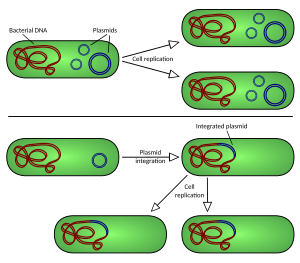DNA construct facts for kids
A DNA construct is like a tiny, custom-made piece of DNA. Scientists build it in a lab. They use it to put new genetic instructions into a cell or tissue.
This special DNA often holds a DNA insert. This insert contains the instructions (a gene) for making a specific protein. This gene is carefully placed inside a molecular biology vector.
DNA constructs can do many things. They might help a cell make a normal protein. They can also stop certain genes from working. Sometimes, they are used to make changed (mutant) proteins. Scientists use DNA constructs a lot in molecular biology. They help us learn more about important molecules like proteins and RNA.
What are Molecular Biology Vectors?
A molecular biology vector is a special DNA molecule. Think of it as a tiny delivery vehicle. Its job is to carry new genetic material into a cell.
The main types of these vehicles are plasmids, bacteriophages (which are viruses that infect bacteria), other viruses, and artificial chromosomes. All engineered vectors have a few key parts. They need a starting point for copying themselves. They also have a spot where new DNA can be easily added. Plus, they have a selectable marker. This marker helps scientists find the cells that successfully took in the new DNA.
The vector itself has two main parts. There's the small piece of new DNA (the transgene). Then there's a larger "backbone" part. This backbone often includes genes that help it grow in bacteria. It also has special signals (promoters) that tell the cell to use the new gene.
The main goal of a vector is to move genetic information into a target cell. This helps scientists study, copy, or make proteins from the new DNA.
Putting a vector into a bacterial cell is usually called transformation. When it goes into eukaryotic cells (like human cells), it's called transfection. If a virus vector is used, it's often called transduction.
Images for kids



